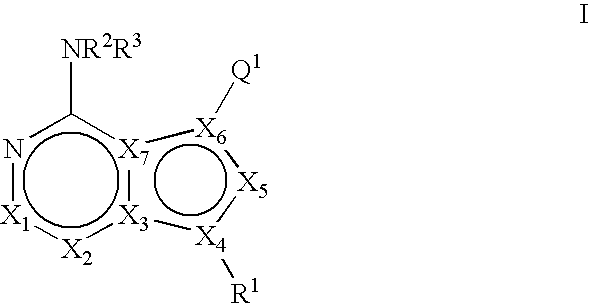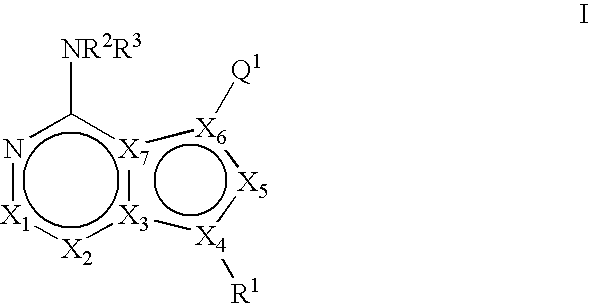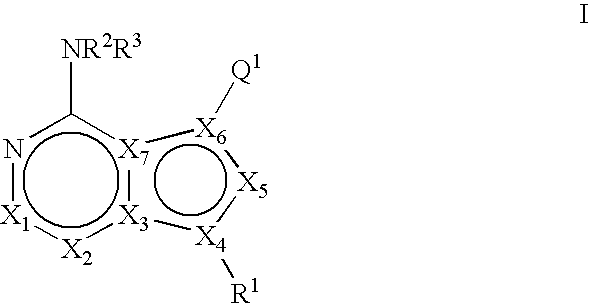Bicyclic protein kinase inhibitors
a technology of bicyclic protein and inhibitor, which is applied in the field of new heterobicyclic compounds, can solve the problems of not being able to effectively fight all mutant isoforms of kit kinase, not being able to develop rapamycin as a cancer therapy, and not being able to cure all species, etc., to achieve the effect of treating and/or preventing hyperproliferative diseases
- Summary
- Abstract
- Description
- Claims
- Application Information
AI Technical Summary
Problems solved by technology
Method used
Image
Examples
example 1
1-(3-Benzyloxy-phenyl)-3-ethoxy-imidazo[1,5-a]pyrazin-8-ylamine
[0328]
[0329] A solution of 1-(3-benzyloxy-phenyl)-8-chloro-3-ethoxy-imidazo[1,5-a]pyrazine (20.0 mg, 0.05 mmol) in i-PrOH (5 mL) was saturated with NH3 at −20° C. and heated in a Parr pressure vessel to 110° C. for 72 h. The reaction was concentrated in vacuo, partitioned between DCM and H2O and separated. The aqueous layer was washed with DCM (3×) and the combined organic layers were washed with brine (1×), dried over Na2SO4, filtered and concentrated in vacuo and purified by chromatography on silica gel [eluting with 2% EtOAc in DCM] to yield the desired product as an off-white solid; 1H NMR (CDCl3, 400 MHz) δ 1.45 (t, J=7.2 Hz, 3H), 4.58 (q, J=7.2 Hz, 2H), 4.91 (brs, 2H), 5.10 (s, 2H), 6.86 (d, J=4.8 Hz, 1H), 6.95-6.99 (m, 1H), 7.04 (d, J=5.2 Hz, 1H), 7.17-7.21 (m, 2H), 7.26-7.43 (m, 7H); MS (ES+): m / z=361.19 (100) [MH+], HPLC: tR=2.36 min (MicromassZQ, polar-5 min).
a) 1-(3-Benzyloxy-phenyl)-8-chloro-3-ethoxy-imidaz...
example 2
3-Ethoxy-1-(2-phenyl-quinolin-7-yl)-imidazo[1,5-a]pyrazin-8-ylamine
[0340]
[0341] 7-(8-Chloro-3-ethoxy-imidazo[1,5-a]pyrazin-1-yl)-2-phenyl-quinoline (20.0 mg, 0.050 mmol) was dissolved into a 80 mL sealed tube with isopropyl alcohol (1.0 mL, 3.0 mmol). The solution was cooled to −20° C. and charged with ammonia gas. The reaction was heated to 110 IC for 72 hours. The reaction was then cooled, concentrated in vacuo and dissolved with CH2Cl2. The crude product was purified via silica gel column chromatography, (Jones, 2.0 gram column; 100% EtOAc) to yield the title compound as a yellow solid; MS (ES+): m / z 382.08 (90) [MH+], 383.09 (30) [MH++]. HPLC: tR=2.26 min (OpenLynx, polar—5 min); 1H NMR (400 MHz, CHLOROFORM-d) δ ppm 1.52 (t, J=7.07 Hz, 3H), 4.66 (q, J=7.07 Hz, 2H), 6.96 (d, J=5.05 Hz, 1H), 7.13 (d, J=5.05 Hz, 1H), 7.34-7.63 (m, 3H), 7.75-8.01 (m, 3H), 8.10-8.32 (m, 3H), 8.40 (s, 1H).
a) 7-(8-Chloro-3-ethoxy-imidazo[1,5-a]pyrazin-1-yl)-2-phenyl-quinoline
[0342]
[0343] A 80 mL sea...
example 3
8-Amino-1-(3-benzyloxy-phenyl)-imidazo[1,5-a]pyrazine-3-carboxylic acid amide
[0356]
[0357] A solution of 1-(3-benzyloxy-phenyl)-8-chloro-imidazo[1,5-a]pyrazine-3-carboxylic acid ethyl ester (100 mg, 0.245 mmol) in anhydrous iPrOH (14 mL) was saturated with NH3 at −30° C. and heated to 110 IC in a Parr pressure vessel for 20 hr. The reaction mixture was concentrated in vacuo and partitioned between DCM and water and separated. The aqueous layer was washed with DCM (3×) and the combined organic layers were washed with brine (1×), dried over Na2SO4, filtered, and concentrated in vacuo. The crude material was dry loaded using hydromatrix and the material was purified by chromatography on silica gel [eluting with 3% MeOH in DCM], resulting in the title compound as an off-white solid; 1H NMR (DMSO-d6, 400 MHz) δ 5.08 (s, 2H), 6.13 (brs, 2H), 7.05-7.10 (m, 1H), 7.15 (m, 1H), 7.18 (d, J=4.8 Hz, 1H), 7.24-7.31 (m, 2H), 7.32-7.44 (m, 5H), 7.62 (brs, 1H), 7.91 (brs, 1H), 8.54 (d, J=4.8 Hz, 1H)...
PUM
| Property | Measurement | Unit |
|---|---|---|
| body weight | aaaaa | aaaaa |
| volume | aaaaa | aaaaa |
| concentrations | aaaaa | aaaaa |
Abstract
Description
Claims
Application Information
 Login to View More
Login to View More - R&D
- Intellectual Property
- Life Sciences
- Materials
- Tech Scout
- Unparalleled Data Quality
- Higher Quality Content
- 60% Fewer Hallucinations
Browse by: Latest US Patents, China's latest patents, Technical Efficacy Thesaurus, Application Domain, Technology Topic, Popular Technical Reports.
© 2025 PatSnap. All rights reserved.Legal|Privacy policy|Modern Slavery Act Transparency Statement|Sitemap|About US| Contact US: help@patsnap.com



